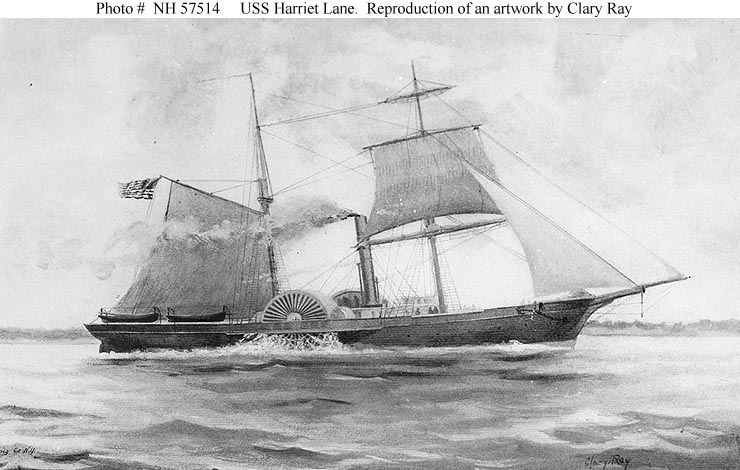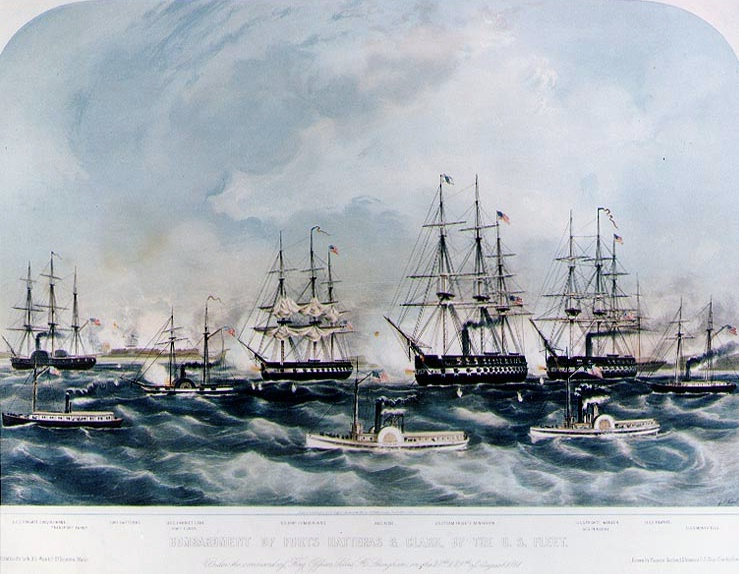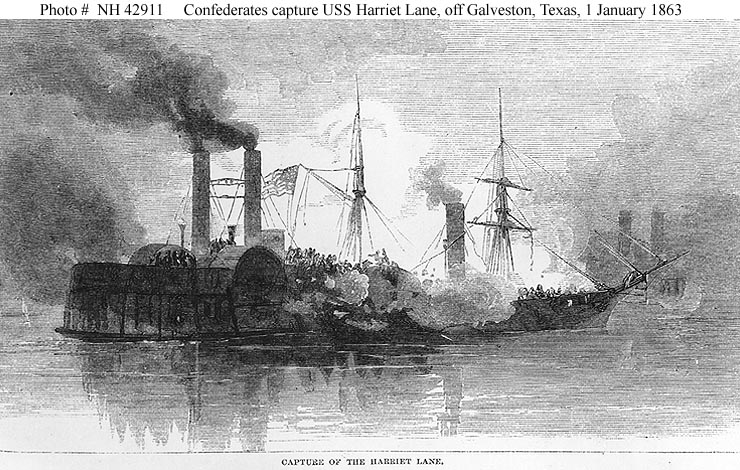|
USS Harriet Lane (1861-1863)
Originally USRC Harriet Lane
(1857-1861)
USS Harriet Lane, a 750-ton side-wheel gunboat, was built at New York
City in 1857 as the U.S. Revenue Cutter Harriet Lane. In addition to carrying out her Revenue Service duties, she served
with the Navy during the Paraguay expedition of 1858-59. Returning to Navy control in late March 1861, as the secession crisis
deepened, Harriet Lane took part in the attempt to relieve Fort Sumter when that vital position in Charleston harbor,
South Carolina, was besieged by Confederate forces. While engaged on 12 April 1861, she fired the first U.S. Navy shot
of the Civil War.
| Harriet Lane |

|
| USRC Harriet Lane (1857-1861); USS Harriet Lane (1861-1863) (USCG) |
In early June 1861, Harriet Lane exchanged fire with an enemy battery
near Newport News, Virginia, and in late August participated in the Navy's initial major combat operation, the capture of
Forts Hatteras and Clark at Hatteras Inlet, North Carolina. She was formally transferred from the Revenue Cutter Service to
the Navy in September. Also during 1861, Harriet Lane captured four prizes while enforcing the blockade and, in December,
fired on Confederate positions at Freestone Point, Virginia.

(Picture) "Bombardment of Forts Hatteras & Clark, by the U.S. Fleet."
Under the command of Flag Officer Silas H. Stringham, on the 28th and 29th of August 1861. Colored lithograph by J. P. Newell
after a drawing by Francis Garland, Seaman on USS Cumberland, published by J.H. Buford, Boston, Massachusetts, 1862.
Features identified below the image are (from left to right): USS Susquehanna; transport Fanny; Fort Hatteras;
USS Harriet Lane; Fort Clark; USS Cumberland (the Cumberland was later destroyed by the CSS Virginia,
which was formerly the USS Merrimack); steamer Adelaide; USS Minnesota; steamer George Peabody;
USS Wabash; USS Pawnee; and USS Monticello. Courtesy of the U.S. Navy Art Collection, Washington,
D.C., U.S. Naval Historical Center Photograph.
Harriet Lane was sent to the Gulf of Mexico in February 1862
to serve as flagship of Commander David Dixon Porter's fleet of
mortar schooners. While en route, she engaged Confederate artillery at Shipping Point, Virginia, and captured a sailing vessel
off the Florida coast. During March and April, Porter's mortar flotilla played an important part in the operations that led
to the capture of New Orleans. Harriet Lane accompanied this force at that time, and during some of its subsequent
activities on the Mississippi River below Vicksburg. In May 1862, she also assisted in the occupation of fortifications at
Pensacola, Florida.

|
| U.S. Naval Historical Center |
(Picture) "Capture of USS Harriet Lane, 1 January 1863." Engraving
published in Harper's "History of the Great Rebellion", page 421, depicting Confederates boarding the Harriet Lane
from the C.S. gunboats Neptune and Bayou City. U.S. Naval Historical Center Photo.
After serving on the blockade off Mobile, Alabama, Harriet Lane participated
in the early October 1862 capture of Galveston, Texas. She remained in the Galveston area and, on 1 January 1863, while inside
Galveston Bay, she was boarded and captured by Confederate troops operating from the steamers Bayou City and Neptune. Following
this bold action, which resulted in the recovery of Galveston by Southern forces, Harriet Lane was employed by the
Confederate Army in Texas waters. In early 1864, she was sold and converted to a blockade runner. Renamed Lavina,
she departed Galveston in late April and arrived in Havana, Cuba. Interned there through the end of the Civil War, she
subsequently became the sailing merchant vessel Elliot Richie and remained in commercial service until May 1884, when
she was lost off Pernambuco, Brazil.
Sources: United States Coast Guard and U.S. Naval Historical Center.
Recommended
Reading: Civil War Navies, 1855-1883 (The
U.S. Navy Warship Series) (Hardcover).
Description: Civil War Warships, 1855-1883 is the second in the five-volume US Navy Warships encyclopedia set. This valuable
reference lists the ships of the U.S. Navy and Confederate Navy during the Civil War and the years immediately following -
a significant period in the evolution of warships, the use of steam propulsion, and the development of ordnance. Civil War
Warships provides a wealth and variety of material not found in other books on the subject and will save the reader the effort
needed to track down information in multiple sources. Continued below…
Each ship's
size and time and place of construction are listed along with particulars of naval service. The author provides historical
details that include actions fought, damage sustained, prizes taken, ships sunk, and dates in and out of commission as well
as information about when the ship left the Navy, names used in other services, and its ultimate fate. 140 photographs, including
one of the Confederate cruiser Alabama recently uncovered by the author further contribute to this
indispensable volume. This definitive record of Civil War ships updates the author's previous work and will find a lasting
place among naval reference works.
Recommended
Reading: Naval Strategies of the Civil War: Confederate Innovations and Federal Opportunism. Description: One of the most overlooked aspects of the American Civil War is the
naval strategy played out by the U.S. Navy and the fledgling Confederate Navy, which may make this the first book to compare
and contrast the strategic concepts of the Southern Secretary of the Navy Stephen R. Mallory against his Northern counterpart,
Gideon Welles. Both men had to accomplish much and were given great latitude in achieving their goals. Mallory's vision of
seapower emphasized technological innovation and individual competence as he sought to match quality against the Union Navy's
(quantity) numerical superiority. Welles had to deal with more bureaucratic structure and to some degree a national strategy
dictated by the White House. Continued below...
The naval blockade
of the South was one of his first tasks - for which he had but few ships available - and although he followed the national
strategy, he did not limit himself to it when opportunities arose. Mallory's dedication to ironclads is well known, but he
also defined the roles of commerce raiders, submarines, and naval mines. Welles's contributions to the Union effort were rooted
in his organizational skills and his willingness to cooperate with the other military departments of his government. This
led to successes through combined army and naval units in several campaigns on and around the Mississippi River.
Recommended
Reading: Civil War Ironclads: The U.S.
Navy and Industrial Mobilization (Johns
Hopkins Studies in the History of Technology). Description:
"In this impressively researched and broadly conceived study, William Roberts offers the first comprehensive study of one
of the most ambitious programs in the history of naval shipbuilding, the Union's ironclad
program during the Civil War. Perhaps more importantly, Roberts also provides an invaluable framework for understanding and
analyzing military-industrial relations, an insightful commentary on the military acquisition process, and a cautionary tale
on the perils of the pursuit of perfection and personal recognition." - Robert Angevine, Journal of Military History "Roberts's
study, illuminating on many fronts, is a welcome addition to our understanding of the Union's industrial mobilization during
the Civil War and its inadvertent effects on the postwar U.S. Navy." - William M. McBride, Technology and Culture"
Recommended
Reading: A History of Ironclads: The Power of Iron over Wood. Description: This
landmark book documents the dramatic history of Civil War ironclads and reveals how ironclad warships revolutionized naval
warfare. Author John V. Quarstein explores in depth the impact of ironclads during the Civil War and their colossal effect
on naval history. The Battle of Hampton Roads was one of history's greatest naval engagements. Over the course of two days
in March 1862, this Civil War conflict decided the fate of all the world's navies. It was the first battle between ironclad
warships, and the 25,000 sailors, soldiers and civilians who witnessed the battle vividly understood what history would soon
confirm: wars waged on the seas would never be the same. Continued below…
About the Author: John V. Quarstein is an award-winning author and historian. He is director
of the Virginia
War Museum in Newport News and chief historical advisor for The Mariners' Museum's new USS Monitor Center
(opened March 2007). Quarstein has authored eleven books and dozens of articles on American, military and Civil War history,
and has appeared in documentaries for PBS, BBC, The History Channel and Discovery Channel.
Recommended
Reading: Rebels and Yankees:
Naval Battles of the Civil War (Hardcover).
Description: Naval Battles of the Civil War, written by acclaimed Civil War historian Chester G. Hearn, focuses on the maritime
battles fought between the Confederate Rebels and the Union forces in waters off the eastern seaboard and the great rivers
of the United States during the Civil
War. Since very few books have been written on this subject, this volume provides a fascinating and vital portrayal of the
one of the most important conflicts in United States
history. Naval Battles of the Civil War is lavishly illustrated with rare contemporary photographs, detailed artworks, and
explanatory maps, and the text is a wonderful blend of technical information, fast-flowing narrative, and informed commentary.
Recommended
Reading: Lincoln and His Admirals (Hardcover).
Description: Abraham Lincoln began his presidency admitting that he knew "little about ships," but he quickly came to preside
over the largest national armada to that time, not eclipsed until World War I. Written by prize-winning historian Craig L.
Symonds, Lincoln and His Admirals unveils an aspect of Lincoln's presidency unexamined by historians until now, revealing
how he managed the men who ran the naval side of the Civil War, and how the activities of the Union Navy ultimately affected
the course of history. Continued below…
Beginning with
a gripping account of the attempt to re-supply Fort Sumter--a comedy of errors that shows
all too clearly the fledgling president's inexperience--Symonds traces Lincoln's
steady growth as a wartime commander-in-chief. Absent a Secretary of Defense, he would eventually become de facto commander
of joint operations along the coast and on the rivers. That involved dealing with the men who ran the Navy: the loyal but
often cranky Navy Secretary Gideon Welles, the quiet and reliable David G. Farragut, the flamboyant and unpredictable Charles
Wilkes, the ambitious ordnance expert John Dahlgren, the well-connected Samuel Phillips Lee, and the self-promoting and gregarious
David Dixon Porter. Lincoln was remarkably patient; he often
postponed critical decisions until the momentum of events made the consequences of those decisions evident. But Symonds also
shows that Lincoln could act decisively. Disappointed by the
lethargy of his senior naval officers on the scene, he stepped in and personally directed an amphibious assault on the Virginia coast, a successful operation that led to the capture of Norfolk.
The man who knew "little about ships" had transformed himself into one of the greatest naval strategists of his age. A unique
and riveting portrait of Lincoln and the admirals under his command, this book offers an illuminating account of Lincoln and the nation at war. In the bicentennial year of Lincoln's birth, it offers a memorable portrait of a side of his presidency
often overlooked by historians.
|

